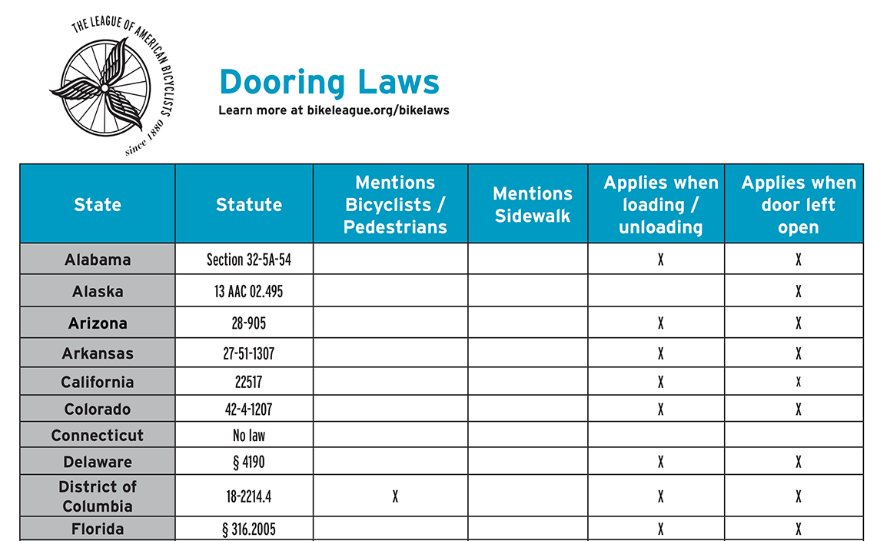DISCOVER YOUR LOCAL BICYCLING COMMUNITY
Find local advocacy groups, bike shops, instructors, clubs, classes and more!
Bike Law U: Dooring
In the latest edition of Bike Law University, the League’s Legal Specialist Ken McLeod looks at dooring laws nationwide. Read more of his bike law analyses here.
Dooring laws are laws that require people in a vehicle to open their door with a degree of care for moving traffic. A typical dooring law requires that a person opening a vehicle door ensure that it is reasonably safe to open the door, that opening the door will not interfere with moving traffic, and that the door is not open for any more time than necessary.
Why should you care?
Dooring laws provide a relatively clear rule to assign responsibility to what some people might see as an unavoidable accident – an opened door hitting or being hit by passing traffic. These laws put the responsibility for opening vehicle doors on the person opening the door, rather than the people passing their vehicle. They provide a clear incentive for people to look for oncoming traffic – whether bikes, cars, or pedestrians – before opening their door. Without this type of law, bicyclists and other people in traffic have to show that they could not avoid an opening or opened door in order to recover for injuries caused by the open door.
“Dooring” collisions are likely one of the more common bicyclist-vehicle collision types, particularly in urban areas. Between 2010 and 2012, data from the City of Chicago showed dooring crashes making up between 7.3 and 19.7% of reported bicycle crashes. The Boston Cyclist Safety Report published in 2013 found that dooring crashes made up between 7 and 13% of all bicycle collisions in Boston between 2009 and 2012. Naturalistic studies, which rely on audio, video, and telemetric data recorded about a bicyclist’s journey, point toward dooring threats being common as an Australian study found that unexpectedly opened vehicle doors accounted for 17.6% of bicyclist driver interactions.
However, more data on dooring would be appreciated, as an example, North Carolina, which done a lot of work to crash-type its bicycle crashes, reports that only a handful of dooring crashes have been recorded each year from 2002 to 2012, for 20 total in that decade. A similar study from Wisconsin using the same crash-typing methodology found similarly low numbers of dooring crashes.
The prevalence of dooring crashes shows the need for dooring laws and public safety campaigns that promote them. In New York City, the LOOK! Campaign has served to remind people in vehicles to look before exiting, especially before opening cab doors. Chicago has adopted a similar campaign and recently raised fines for persons who open doors without looking. The Model Minimum Uniform Crash Criteria, promoted by the National Highway Traffic Safety Administration, Governors Highway Safety Administration and USDOT for law enforcement documentation of motor vehicle crashes, do not appear to include data elements that capture dooring.
Some bicycling-related laws and bicycle infrastructure can contribute to dooring risks:
- Where to ride laws in some jurisdictions that require bicyclists to ride as far to the right as practicable without exceptions can be interpreted to require bicyclists to ride within the door zone, or justify why it is not “practicable” to ride within the door zone.
- Bicycle lanes can be striped so that they place bicyclists within the “door zone.” In certain jurisdictions this can create the situation where a bicyclist is required by law to ride within the door zone. In some jurisdictions worries about bicycle lanes within the door zone have led to improved treatments that stripe the bicycle lanes outside the door zone and/or provide a hashed buffer to make bicyclists and motorists aware of the danger.
Who has them?
Forty states have a dooring law. The ten states without a dooring law are: Connecticut, Indiana, Iowa, Kentucky, Michigan, New Jersey, North Carolina, Tennessee, Virginia, and West Virginia. In thirty-eight states the dooring law applies to people leaving their door open longer than necessary to load or unload a passenger or cargo, as well as when a door is opened without caution.
Click here to view how your state stacks up
Spotlight State: Rhode Island
The dooring law in Rhode Island has several notable characteristics that help bicyclists, pedestrians, and motorists understand the intent of the law. Perhaps most notably, Rhode Island is one of only three states to specifically clarify that bicyclists and pedestrians are part of traffic. In many states the dooring law only references “traffic” leaving it up to interpretation or a reference to a definition found elsewhere in the vehicle code. Massachusetts, Rhode Island, and Oregon clarify that bicyclists and pedestrians are protected by their dooring law. Rhode Island also clarifies that its dooring law applies to bicyclists and pedestrians on sidewalks, shoulders and bicycle lanes.
In addition to doing a great job of making sure that bicyclists and pedestrians are protected by its law, Rhode Island’s law reflects the most modern formulation of the UVC provision on dooring. This means that it applies to both sides of a vehicle and that it applies when doors are left open.
Where did they come from?
Dooring laws were introduced to the Uniform Vehicle Code in 1956 as UVC §11-1105. It was amended in 1962 and 1975, but has not been updated since 1975.
